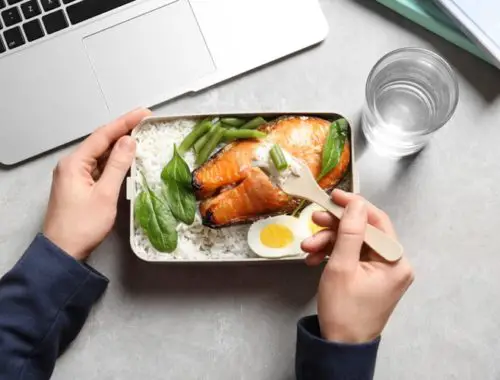If you are concerned about how much salt is in your body, then you’re probably searching for ways on how to get rid of salt. Here’s a great place to start! If you’re not concerned with your salt intake, then you should be!
Really? Regardless if you have a chronic disease like heart disease, diabetes or high blood pressure (or are a healthy person), everyone should be concerned with how much salt is in your body.
In this article, we will get to the bottom of why components of salt are both essential and harmful to your health. We’ll break down the salt molecule so that you can better understand what happens when we eat salt and if salt is the main culprit of your health problems. Finally, we will give you several tips on how to flush salt out of your body so you can start living a healthier life.
Is Salt Bad for You?
When you think of a healthy diet, you may think that salt is bad for you. As salt breaks down in your body, however, it breaks into 2 minerals called sodium and chloride. These 2 minerals are essential for maintaining normal body functions, so we do need them in our diet. However, when we have an imbalance of these minerals, especially sodium, then that is when we start seeing health issues.
Your body works hard to tightly control your blood sodium levels regardless of your sodium intake, however, there are several problems that are possible when someone’s blood sodium levels are abnormal.
| Editor’s Picks | Brand | Rating |
|---|---|---|
| Best Overall | Concept2 Model D Indoor Rowing Machine | 4.9 |
| Runner Up | Stamina Avari Programmable Magnetic Exercise Rower | 4.0 |
| Best Budget Buy | Sunny Health & Fitness SF-RW5639 Full Motion Rowing Machine | 4.2 |
| Best Water Rowing Machine | WaterRower Natural Rowing Machine | 4.7 |
| Best Folding Rowing Machine | Circuit Fitness Deluxe Foldable Magnetic Rowing Machine | 4.2 |
Above all, while salt consumption needs to be controlled, nutrition professionals are most concerned with your sodium intake. So, watch your sodium intake! For most adults, sodium intake should be limited to 1500mg to 2300mg per day. If you have high blood pressure, then reduce your sodium intake to 1500mg per day (1).
Keep the Sodium Out (Before It Gets In)
One of the first steps you can take to get rid of sodium from your body is to reduce consumption of it in the first place. Here are some tips on how to do that:
1. Avoid Adding Salt to Your Foods
Perhaps one of the easiest and clear-cut ways to reduce your sodium is to get that salt shaker off the table and out of your food! Just about 1 teaspoon of salt contains all the recommended sodium you need in a day! To add flavor to your foods without sodium and salt, try the Mrs. Dash flavor packets.
2. Read the Nutrition Label for Sodium
When you are trying to reduce your sodium intake, it is essential that you read the nutrition label so that you understand how much sodium is in the food you are buying. Remember to keep it to less than 2300mg per day (and less than 1500mg if you have hypertension). For information about labeling and how to understand the food label for sodium, click here.
3. Recognize the Patterns of Sodium in Food
Do you think at the salt in a salt shaker is where we get most of our sodium? Think again! There are various types of foods that are typically high in sodium and types of foods that are typically low in sodium. Overall, try to decrease the amount of high sodium foods in the diet while increasing the low sodium foods.
| Editor’s Picks | Brand | Rating |
|---|---|---|
| Best Overall | Ninja Blender/Food Processor | 4.3 |
| Runner Up | NutriBullet Rx N17-1001 Blender | 4.2 |
| Best Budget Buy | Hamilton Beach 51131 Single-Serve Blender | 3.7 |
| Best Personal Smoothie Maker | Ninja Personal Blender | 4.6 |
| Best Portable Smoothie Blender | ECPURCHASE Portable Blender | 4 |
*While these foods can be part of a healthy diet to manage hypertension, portion control should be conducted.
Fun Fact: Try rinsing your canned goods (i.e. canned green beans, beans, corn) in a colander under cool water because you can rinse a little bit of the sodium off that way!
Flush the Sodium Out (Once It’s Already In)
Monitoring your sodium intake is a lifelong process that we all must work on in order to stay healthy. However, there are some ways to help your body process and flush out sodium when it is in your body.
1. Keep Your Kidneys Healthy
Your kidneys process fluid, sodium and other substances based on what your body needs (and what it doesn’t). Make sure you visit your doctor regularly so that he or she can monitor how well your kidneys are working. Check out this article to learn more about keeping your kidneys healthy and how to detox naturally.
2. Drink Enough Water
Remember this: Where water goes, sodium will follow. Drinking water will hydrate your body and help you flush out sodium, especially if there is too much sodium circulating in the body. When we do not drink enough water, our kidneys can’t work correctly, and ultimately, can’t flush out excess sodium.
3. Get Your Sweat On
We lose some sodium via sweat when we exercise, so get your sweat on with this fun workout DVD package (2)! While this is not as effective as eliminating sodium via diet, perhaps this can be yet another reason for you to exercise. One thing to keep in mind, however, is that you should stay adequately hydrated before, during and after a sweat session. If you sweat profusely (for no apparent reason), then you may have an underlying medical condition. So, always check in with your doctor!









